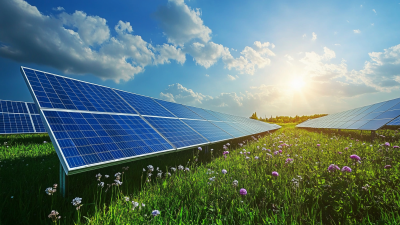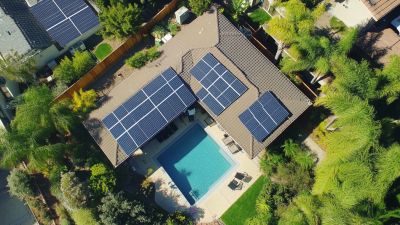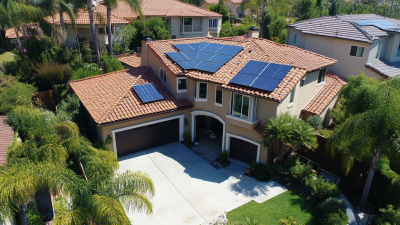Blog
- Home
- Blog
5 Best Power Solar Solutions Revolutionizing Renewable Energy Efficiency in 2023
In an era where renewable energy is at the forefront of global sustainability efforts, "Power Solar" solutions are leading the charge towards enhanced efficiency and environmental responsibility. As we enter 2023, innovative technologies and practices are emerging to revolutionize how we harness solar energy, addressing long-standing challenges faced by the industry. This blog will delve into the five best power solar solutions that are not only improving energy output but also redefining the very concept of efficiency in renewable energy systems. With an increasing demand for clean energy alternatives, these groundbreaking solutions promise to mitigate problems related to traditional energy sources, ushering in a new era of sustainable energy practices that will benefit both our planet and future generations. Join us as we explore the forefront of solar technology and its transformative impact on our commitment to a greener tomorrow.

Innovative Solar Technologies Shaping Renewable Energy in 2023
In 2023, innovative solar technologies are not only enhancing energy efficiency but are also reshaping the landscape of renewable energy. According to the International Energy Agency (IEA), global solar power capacity reached an impressive 1,041 GW by the end of 2022, marking a 24% increase over the previous year. This trend is expected to accelerate as new advancements in photovoltaic (PV) technology and energy storage solutions become available. Innovations such as bifacial solar panels, which capture sunlight on both sides, are pushing efficiency rates upward, with some models achieving over 22% efficiency in field conditions.
Furthermore, the integration of artificial intelligence in solar energy management is revolutionizing how we harness and utilize solar power. AI-driven systems can optimize energy output by predicting sunlight availability and adjusting the operation of solar arrays dynamically. A report from the Solar Energy Industries Association (SEIA) highlighted that deploying AI technologies could increase solar generation efficiency by up to 30% in the next decade. As these technologies continue to advance, they are not only bolstering the effectiveness of solar energy but also laying the groundwork for a more sustainable and resilient energy future.
Top 5 Solar Power Solutions Enhancing Efficiency and Sustainability
As the energy sector evolves, innovative solar solutions are becoming pivotal in enhancing efficiency and sustainability. Notably, floating solar panels are gaining traction, especially in water-scarce regions of India. According to a report by the International Renewable Energy Agency (IRENA), floating solar installations can reduce land use conflicts and increase energy generation by leveraging otherwise unused water surfaces. The largest floating solar project in India, situated on a reservoir, has the potential to power thousands of homes while minimizing evaporation and providing an ecological refuge.
Moreover, advancements in photovoltaic (PV) technology continue to reshape the landscape of renewable energy. A recent analysis from the National Renewable Energy Laboratory (NREL) suggests that modern PV modules are achieving efficiencies upwards of 22%, with projections indicating that innovations could push these numbers even higher. This evolution in solar technology not only contributes to the global shift towards cleaner energy but also demonstrates significant cost reductions. The levelized cost of electricity (LCOE) for solar power has decreased by more than 80% since 2010, making it a competitive and sustainable energy source on a global scale.

Game-Changing Solar Panel Designs Driving Energy Revolution
 In 2023, the solar energy landscape is witnessing a remarkable transformation, primarily driven by
innovative panel designs that enhance efficiency and sustainability. With solar installations projected to reach
over 200 GW globally, according to the International Renewable Energy Agency (IRENA),
these game-changing technologies are critical in maximizing energy output while minimizing carbon footprints.
New bifacial solar panels, for instance, can capture sunlight on both sides, which can increase energy generation
by up to 30%, making them a game-changer in the race for cleaner energy.
In 2023, the solar energy landscape is witnessing a remarkable transformation, primarily driven by
innovative panel designs that enhance efficiency and sustainability. With solar installations projected to reach
over 200 GW globally, according to the International Renewable Energy Agency (IRENA),
these game-changing technologies are critical in maximizing energy output while minimizing carbon footprints.
New bifacial solar panels, for instance, can capture sunlight on both sides, which can increase energy generation
by up to 30%, making them a game-changer in the race for cleaner energy.
As we explore these advancements, it's essential for consumers to consider not just the initial cost but also the long-term savings and efficiency of solar panels. Tip: When selecting solar panels, look for those with a high degradation rate and a solid warranty. This can indicate higher longevity and performance over time, ensuring your investment is protected. Additionally, investing in smart solar inverters can optimize energy consumption and provide real-time data on energy usage, making it easier for homeowners to manage their energy needs effectively.
Furthermore, the integration of solar tracking systems is revolutionizing how panels harness sunlight. These systems adjust the angle of solar panels throughout the day to follow the sun's trajectory, potentially increasing energy capture by an estimated 25-35%. Tip: Explore options for solar tracking as part of your installation, especially if you have ample rooftop space. This not only enhances efficiency but can also significantly reduce reliance on grid power, promoting energy independence. With these innovative solutions, the future of renewable energy looks brighter than ever.
Leading Solar Companies Pushing the Boundaries of Clean Energy
In 2023, the solar energy sector is witnessing extraordinary innovation, with leading companies at the forefront of these advancements. Pioneers in clean energy are developing cutting-edge technologies that enhance the efficiency of solar panels, making renewable energy more accessible than ever. These efforts are not only aiming to reduce carbon footprints but also address the rising global energy demands with sustainable solutions. Companies are adopting smart solar technologies that integrate AI and big data to optimize energy production and predict performance, ensuring that solar power becomes a cornerstone of the energy mix.
One notable player in this revolution is SolarTech Innovations, which has launched a breakthrough solar module that boasts a 25% increase in energy conversion efficiency compared to traditional designs. Additionally, EcoPower Solutions is making strides with its unique bifacial technology that captures sunlight from both sides of the panel. Such advancements are pushing the boundaries of what renewable energy can achieve, inspiring other sectors to follow suit. As these companies continue to innovate, the future of solar energy appears brighter and more promising, paving the way for a supportive infrastructure that encourages widespread adoption and integration of clean energy in everyday life.
Renewable Energy Efficiency in 2023
Future Trends in Solar Energy: What to Expect Beyond 2023
The solar energy sector is poised for transformative growth beyond 2023, particularly in the realm of perovskite solar cells, which are increasing in market significance. In 2023, the global perovskite solar cell market was valued at an impressive $301.3 million, with projections indicating a dramatic rise to $4.732 billion by 2024, and an astounding $15.4996 billion by 2031. This rapid expansion underscores the potential of perovskite technology to outperform traditional solar solutions, driven by advancements in efficiency and reduced production costs.
Meanwhile, the photovoltaic (PV) market in the Middle East and Africa is also on an upward trajectory, with estimates suggesting growth from $6.93 billion in 2023 to $37.71 billion by 2030, achieving a remarkable compound annual growth rate (CAGR) of 27.4%. This surge is indicative of the region's increasing investment in renewable energy infrastructure and its commitment to sustainable energy solutions. Additionally, the solar PV components market is expected to witness significant growth, expanding from $58.4 billion in 2023 to approximately $153.92 billion by 2032, further solidifying solar energy’s role in the global energy landscape.
5 Best Power Solar Solutions Revolutionizing Renewable Energy Efficiency in 2023
| Solar Technology | Efficiency (%) | Cost per Watt ($) | Expected Lifespan (Years) | Key Features |
|---|---|---|---|---|
| Monocrystalline Solar Panels | 20-22 | 0.80 | 25 | High efficiency, longer lifespan |
| Bifacial Solar Panels | 22-24 | 0.90 | 30 | Dual-side collection, higher yield |
| Thin-Film Solar Panels | 10-13 | 0.50 | 20 | Lightweight, flexible, cost-effective |
| Building-Integrated Photovoltaics (BIPV) | 15-18 | 1.50 | 25 | Seamless integration into architecture |
| Concentrated Solar Power (CSP) | 20-25 | 3.00 | 30+ | Storage capacity, high efficiency in sunny areas |
Related Posts
-

Exploring the Versatile Features and Applications of Best Power Solar Products
-

Navigating Tariff Challenges: How Chinese Manufacturers Thrive with Best Solar Electricity Solutions
-

Exploring the Future of Best Power Solar Energy Trends in 2025 Beyond Solar Revolution
-

7 Ultimate Benefits of Choosing Power Solar Energy for Your Global Supply Needs
-

Unlocking the Future of Power Solar Energy Your Comprehensive Purchasing Guide
-

Unlocking Sustainable Energy Trade 7 Key Certifications for Residential Solar Systems